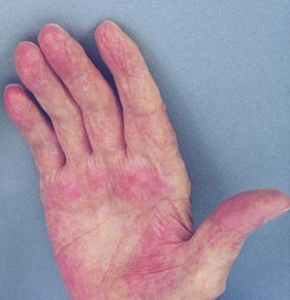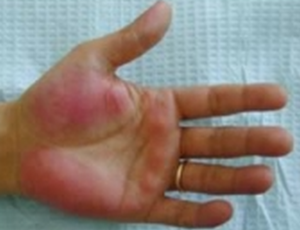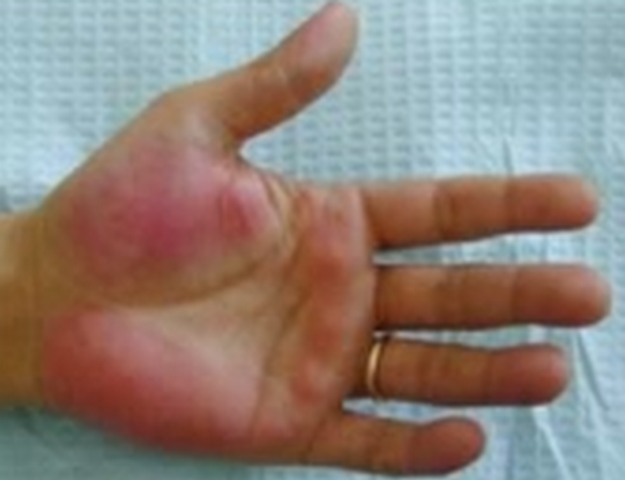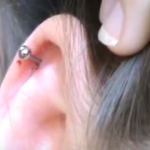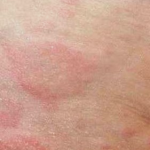Palmar erythema is a self-restrictive disease localized only to the palm of the hands. It is not a condition by itself, but often may be associated with other underlying diseases and disorders.
Palmar erythema is marked by reddening of the palm of the hand, especially the base of the thumb and little finger. As the symptoms and effects of the condition are limited to the palms, it is not serious and quite harmless. It may affect healthy as well as people without any history of medical problems. However, patients need to seek medical attention so as to know the root cause for the skin disorder.
Palmar erythema occurs in two levels, namely primary palmar erythema and secondary palmar erythema.Palmar erythema usually affects people suffering with rheumatoid arthritis and women using oral contraceptives. Around thirty per cent of pregnant woman and twenty-three per cent of liver cirrhosis patients may experience palmar erythema. The cause for palmar erythema is usually linked with high blood pressure. It is not easy to differentiate from other skin disorders due to its similar features with other skin conditions.Reddening of the soles of the feet is known as plantar erythema.
Features of Palmar Erythema
The four main features of palmar erythema which help distinguish it from other patches on the palms are as follows:
- No itchy feeling
- Symmetrical patches
- Lightly warm to touch
- No pain
Symptoms
Some of the signs and symptoms of palmar erythema are as follows:
- Reddening of the palm of the hands:The palm of the hands, especially thumb and base of the little finger becomes red. The redness and other symptoms may spread across the palm; however the commonly affected areas are thenar and hypothenar.
- Inflammation of skin: A person experiencing palmar erythema will not suffer from itchy feeling, pain, and scaling. However, the person may experience inflammation.
- Blanching and molting: Patients may also experience blanching and molting whenever pressure is applied. After pressure is released, it returns to its previous red color. The reddening of the palm may vary from person to person. For some it may be light red whereas for another it may be deep red or pink. Also, the reddening can spread to the fingers and the nail folds near hypothenar and thenar.
Causes of Palmar Erythema
Palmar Erythema occurs in two forms namely, primary palmar erythema andsecondary palmar erythema. In the primary form, the cause is not associated or is secondary to a causal state. The root cause for palmar erythema is not clear and cannot be linked to a present medical situation.
The causes of primary palmar erythema can include:
- Pregnancy: Thirty percent of pregnant women are prone to experiencing primary palmar erythema. Pregnancy is the most general reason for the condition of the palms. It is believed that increased level of estrogens in the body during pregnancy may act as the trigger. It is also thought that it has links to the changes in the functions of the vasculature and skin.
- Heredity: Palmar erythema may also occur due to hereditary reasons, although this is very rare.
- Idiopathic: In this case, doctors are not aware of the exact cause or cannot diagnose the exact cause of palmar erythema.
Secondary palmar erythema occurs as secondary to present underlying state or that which is influenced by a major illness.
- Neoplasm: Neoplasm if it affects, especially the liver, then there is high risk of palmar erythema. The development of cancer can increase the estrogen levels.
- Severe liver illness:Liver cirrhosis and other serious diseases of the liver can influence the occurrence of palmar erythema because of the increase in the level of estrogens or anomalies in estradiol levels.
- Hyperthyroidism: A person suffering from hyperthyroidism will have increased level of estradiol-17-beta, this will likely lead to palmar erythema.
- Rheumatoid arthritis:This condition is regarded as one of the most general reasons or common causes of palmar erythema. Around sixty per cent of rheumatoid arthritis patient suffer from palmar erythema.
Some other causes are:
- Smoking
- Sarcoidosis
- Consumption of medicines may also cause reddening of palms of the hands. Some of the culprit drugs include amiodarone, gemfibrozil, cholestyramine, topiramate, and salbutamol.
- Gestational syphilis
- Polycythaemia.
- Severe mercury poisoning
- Diabetes mellitus
Treatment of Palmar Erythema
There is no clear treatment specified for palmar erythema. Treatment includes detection of the cause of primary palmar erythema and then curing it as per the available standard medical procedures. If the reason for palmar erythema is said to be secondary to a medicine, then it is advised to stop intake of the specified drug. Treatment will not guarantee that it will improve the reddening of the palms of the hand.
People with good health who are suffering from palmar erythema need not worry as it tends to resolve on its own in some time without medical treatment. It is however important for all patients, including healthy people, to consult a doctor.
Palmar Erythema – Pictures
